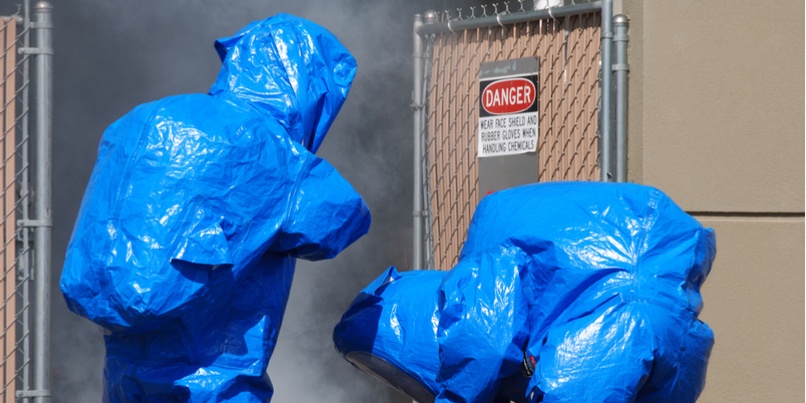
An essential requirement of every CBRNe and HazMat responder is to be able to provide rapid, safe and effective response in the event of a civil or military emergency. And critical to that preparedness is the creation of Real Experience Training scenarios which ensure personnel can demonstrate their proficiency in handling any situation with confidence and control.
The ever expanding array of fielded detection systems has generated a critical need for versatile new platforms that deliver the highest possible standards in training. As such, hazardous material detector simulators have a vital role to play in creating realistic CBRNe and HazMat safety training exercises that are scalable, versatile, repeatable and, above all else, safe.
In this blog post we explore 7 key factors to keep in mind when sourcing simulator detectors for your training scenarios.
1 Realism
Delivering authentic and engaging CWA and HazMat training scenarios is essential for effective learning. Realism is especially important in the creation of radiation safety scenarios where the “invisible threat” of radiation generates no immediate sensation for students to experience. While radiation detectors themselves are fairly simple to use, the key is in creating realistic scenarios that replicate the instrument readings and responses that participants will experience in real-life incidents. Authenticity is crucial, both in terms of the look, feel and response of the detector and the physical and environmental challenges that the scenario recreates.
2 Repeatability
Another key question to consider is whether your HazMat training device offers the flexibility of frequent and repeated use within the environment of your choice. Repetition is the key to consolidating learning, so ideally you’ll want to be able to train as often and as diversely as you choose to, including sensitive locations be that indoors, outdoors, hot or cold . If your CBRNe or HazMat scenarios are limited by unavoidable delays in the resetting of equipment, essential decontamination procedures, special permissions, regulatory administration, or the clean-up time between exercises then this may have an adverse effect on the success of your training. If you are looking to devise multiple and unlimited scenarios that can be carried out in any setting and which are suitable for individual or group use, simulator detectors may offer the solution.
3 Cost
Assessing the value for money of your training detector can extend well beyond the initial purchase price. Equally is relevant is the lifetime cost of ownership of the selected training method. Will there be additional costs associated with any ongoing maintenance and servicing of your devices for example? And is there any repeated expense of acquiring, transporting and handling any radioactive sources, chemicals or gases that are vital to the operation of the detector? You may also want to consider the effect that the use of any simulant may have on the detector over time. In order to ensure operational readiness is maintained at all times, you’ll want to minimise the wear and tear on your devices. Simulator detectors that use a commercial battery supply, on the other hand, can offer an affordable and practical solution which requires no preventive maintenance and minimises the lifetime cost of ownership.
4 Feedback
Learning comes from repetition, reinforcement and, most crucially of all, from learning from one’s mistakes. And understanding where things have gone wrong can be just as important as getting things right. The use of any CBRN or HazMat detector requires the student to follow a clear set of procedures and feedback on how successfully a trainee has adhered to the process is a key element of the learning experience. If a crucial step has been missed, it’s essential that the simulator / training system is able to record these errors and student activity to create an after-action-review (AAR) report which can be reviewed either during or after the exercise.
5 Safety
The aim with any HazMat or CBRNe training exercise is to create realistic scenarios but at what cost to the environment? The use of simulant chemicals or vapours in open-air testing, for example, can saturate the training environment and pose serious potential health and safety risks to you and your students. Any training that takes place outdoors needs to be carefully controlled - from the time of day it is conducted to the appropriate weather conditions and the quantity of agent that can be released. The use of radiological sources has safety implications for both students and instructors. Simulator detectors, in contrast, offer an authentic HazMat training option with zero environmental impact.
6 Efficiency
The process of ordering, storing, transporting and handling radiological sources and chemicals and gases for simulant detection scenarios requires administration, time and effort that may be better spent in delivering authentic and high-quality training. The use of simulator detectors, on the other hand, enables scenarios to be set up in a matter of minutes.
7 Credibility
Finally too, it’s worth considering the track record of the company that you're considering purchasing from. Do they have strong relationships with the leading detector manufacturers to ensure realism and ongoing logistical support? Are they technologically innovative and committed to the highest levels of simulation fidelity? Have they implemented quality assurance systems and do they design and manufacture with due regard for environmental sustainability?
Modern CBRNe and HazMat threats are many and varied, from clandestine laboratory research, to chemical improvised explosive devices, large or local area reconnaissance, threat assessment and decontamination. The use of simulator detector instruments enables military personnel and first responders to experience realistic and compelling training scenarios of the highest possible standard.





